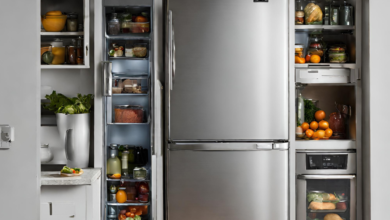Sizing Considerations for a Well-Proportioned Kitchen Refrigerator

The kitchen refrigerator stands as a cornerstone of modern living, playing a pivotal role in preserving and storing perishable goods. Selecting the right-sized refrigerator for your kitchen is crucial not only for aesthetic purposes but also for practicality and energy efficiency. In this comprehensive guide, we will delve into the intricate details of sizing considerations for a well-proportioned kitchen refrigerator, exploring factors such as kitchen layout, family size, lifestyle, and energy efficiency.
I. Kitchen Layout and Spatial Dynamics
A. Built-In vs. Freestanding
1. Built-In Refrigerators
Built-in refrigerators are seamlessly integrated into cabinetry, providing a sleek and customized appearance. When considering the size of a built-in refrigerator, it’s essential to account for the surrounding cabinetry dimensions to achieve a cohesive look. Measure the available space carefully, including height, width, and depth, to ensure a snug fit.
2. Freestanding Refrigerators
Freestanding refrigerators offer more flexibility in terms of placement. Consider the available floor space and ventilation requirements when choosing the size of a freestanding refrigerator. Additionally, factor in door swing direction to prevent any obstruction in the kitchen traffic flow.
B. Counter-Depth vs. Standard Depth
1. Counter-Depth Refrigerators
Counter-depth refrigerators are designed to align with standard kitchen countertops, providing a built-in appearance without sacrificing storage space. When sizing a counter-depth refrigerator, be mindful of the reduced depth compared to standard models. Measure the counter-depth carefully to ensure a seamless and aesthetically pleasing integration.
2. Standard Depth Refrigerators
Standard depth refrigerators offer more storage capacity but may protrude slightly beyond the counter line. When opting for a standard depth model, consider the overall kitchen layout and available space to prevent any visual disruptions.
II. Family Size and Storage Needs
A. Determining Refrigerator Capacity
1. Understanding Cubic Feet Measurement
Refrigerator capacity is often measured in cubic feet. To determine the suitable size for your family, assess your weekly grocery shopping habits and the types of items you regularly store. A general guideline is to allocate around 4 to 6 cubic feet of space per adult in the household.
2. Consideration for Special Features
If you frequently host gatherings or entertain guests, consider a refrigerator with additional features such as adjustable shelves, humidity-controlled drawers, and flexible storage compartments. These features can enhance the overall storage capacity and organization of the refrigerator.
B. Freezer Size and Placement
1. Top-Freezer vs. Bottom-Freezer vs. Side-by-Side
- Top-Freezer: Suitable for those who prioritize fresh food access. Consider the width and depth to ensure adequate space for frozen items.
- Bottom-Freezer: Offers convenient access to fresh food at eye level. Pay attention to the freezer’s width and depth, especially if you opt for a French door configuration.
- Side-by-Side: Provides equal access to both fresh and frozen items. Measure the width to ensure ample space for wide items such as pizza boxes.
III. Lifestyle and Special Considerations
A. Specialty Refrigerators
1. Compact Refrigerators
Compact refrigerators are ideal for small kitchens, offices, or as additional storage in entertainment areas. Consider the available space and whether the refrigerator will serve as a primary or secondary storage unit.
2. Drawer Refrigerators
Drawer refrigerators offer a unique and stylish alternative. When incorporating drawer refrigerators into your kitchen design, account for their dimensions and ensure easy accessibility.
B. Smart Refrigerators and Connectivity
1. Integration with Smart Home Systems
Smart refrigerators come equipped with features such as touchscreens, cameras, and connectivity options. Assess the dimensions of the smart refrigerator and ensure compatibility with your kitchen layout. Consider whether the added technological features align with your lifestyle and preferences.
IV. Energy Efficiency and Environmental Impact
A. Energy Star Certification
1. Understanding Energy Star Ratings
Energy Star-certified refrigerators adhere to strict energy efficiency guidelines. Check for the Energy Star label and review the annual energy consumption to minimize long-term energy costs.
B. Proper Ventilation and Clearances
1. Optimizing Refrigerator Efficiency
Ensure proper ventilation by maintaining recommended clearances around the refrigerator. This not only enhances energy efficiency but also extends the lifespan of the appliance.
V. Conclusion
Choosing the right-sized refrigerator involves a meticulous evaluation of your kitchen space, family size, lifestyle, and environmental considerations. By delving into the detailed aspects of sizing considerations, you can make an informed decision that not only enhances the aesthetics of your kitchen but also optimizes functionality and efficiency. Whether you opt for a built-in, counter-depth, or freestanding refrigerator, understanding the nuances of sizing ensures a well-proportioned addition to your kitchen, meeting both your practical and aesthetic needs.






